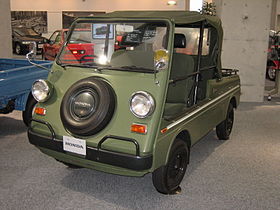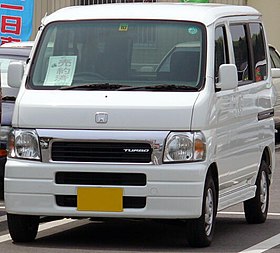Honda Vamos
| Honda Vamos | |
|---|---|
 |
|
| Overview | |
| Manufacturer | Honda |
| Production | 1970–1973 |
| Body and chassis | |
| Class | kei truck |
| Body style | 2-door jeep |
| Layout | Mid engine, rear drive |
| Related | |
| Powertrain | |
| Engine | 354 cc I2 |
| Transmission | 4-speed manual |
| Dimensions | |
| Wheelbase | 1,780 mm (70.1 in) |
| Length | 2,995 mm (117.9 in) |
| Width | 1,295 mm (51.0 in) |
| Height | 1,655 mm (65.2 in) |
| Curb weight | 520 kg (1,146.4 lb) |
| Honda Vamos | |
|---|---|
 |
|
| Overview | |
| Manufacturer | Honda |
| Also called | Vamos Hobio |
| Production | 1999-present |
| Body and chassis | |
| Class | microvan |
| Body style | 5-door hatchback |
| Layout | Mid engine, rear drive/4WD |
| Related |
Honda Acty microvan 3rd generation Mooku Reve |
| Powertrain | |
| Engine | |
| Transmission |
|
| Dimensions | |
| Wheelbase | 2,420 mm (95.3 in) |
| Length | 3,395 mm (133.7 in) |
| Width | 1,475 mm (58.1 in) |
| Height | 1,775 mm (69.9 in) |
| Curb weight | 1,070 kg (2,358.9 lb) |
| Chronology | |
| Predecessor | Honda Street trim level |
The Honda Vamos was a Mini SUV leisure vehicle originally produced by Japanese automaker Honda from 1970 to 1973, and reintroduced again as a trim level of the Honda Acty microvan starting in 1999. Its name, "Vamos", is Spanish for "let's go".
The Vamos was available with an optional and removable rear seat, whereas the Vamos was known as the Vamos 2 or the Vamos 4, for its ability of passenger capacity. It was also available with lap only seat belts for all passengers. The convertible top was easily and quickly removed as needed. Due to the open cab configuration, all instrumentation and switches were both water- and dust proof. It used a MacPherson strut front suspension and a De Dion tube with half leaf springs in the back.
The Honda Vamos name was reintroduced in 1999, and was joined by its twin, the Honda Vamos Hobio in 2003. Both are microvans with 659 cc straight-3 SOHC E07Z gasoline engines and are upper trim level versions of the Honda Acty van. Four wheel drive is optional, using Honda's Full Time 4WD system that utilizes a viscous coupling. It features independent suspension with front coil springs and rear leaf springs. The engine is also available with a turbocharger with the maximum horsepower being limited to 65PS.
The Vamos is marketed more for personal use whereas the Acty van and truck are geared more towards commercial and industrial uses, and as delivery vehicles. Some of the luxury items found on the Vamos are not available on the Acty. The Vamos competes with the Suzuki Every van, the Subaru Sambar van and the Daihatsu Atrai van in Japan.
...
Wikipedia
